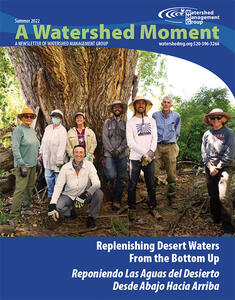What creek do you daydream about on a summer day?
I often dream of Sabino and Tanque Verde Creeks, some of my favorite riparian areas in Tucson. In June, I anticipate the monsoon rains coming that will replenish our creeks and swimming holes, and the sweaty bike rides that will transport me to the creek ending with a refreshing dip.
While the Colorado River needs our attention, so do all the smaller creeks and rivers that make up our watersheds and give us so much joy. Many of these creeks across the West depend on groundwater to sustain flows.
This newsletter highlights Tanque Verde Creek, a creek that historically had stretches of year-round and seasonal flows on Tucson’s east side. Fed by mountain runoff and snowmelt, and sustained by shallow groundwater, unsustainable development and overpumping dried it up for decades.
But the tide may be turning. This year, WMG Flow365 volunteers documented a major milestone along the middle stretch of Tanque Verde Creek: 288 days of consecutive flow.
This data reinforces a trend we’ve seen over the last year of returning seasonal flows, thanks to a reduction in local groundwater pumping and cumulative conservation efforts.
While the Tanque Verde’s recent flows are modest, the creek’s story provides tangible hope for our watershed and beyond, especially in a time of drought and climate change. Tanque Verde Creek tells us it is possible to restore groundwater-based river flows, if groundwater levels are restored.
How do you restore groundwater? You take a holistic, watershed approach: reduce pumping, increase recharge with rain gardens and green infrastructure, preserve the floodplain, remove thirsty invasive species (like Arundo donax), and expand native riparian forests.
In a place like Tanque Verde Creek, restoration is done by hundreds of individuals replenishing the creek from the bottom-up – through grassroots efforts that ultimately recharge the aquifer below their feet.
Next time you daydream about your favorite creek, think about what you can do to ensure that creek thrives for future generations. I invite you to join other River Run Network members at one of our upcoming workshops to remove Arundo donax, or install a rain garden to conserve and recharge more water. Join me and other community scientists in WMG’s Flow365 and Binational Beaver Surveys this fall. Or simply walk along your nearest creek and pick up trash.
The creek will thank you!
Lisa Shipek, Executive Director

